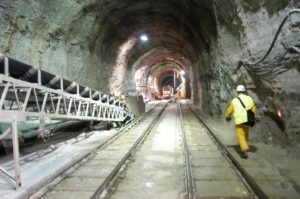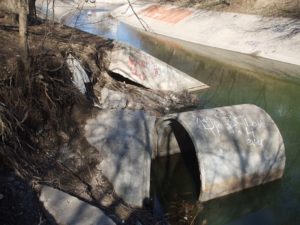Hurricane Harvey should be a wake-up call for anyone who manages infrastructure in our nation’s cities. It has refocused the need for new approaches to be created and implemented that not only strengthen our traditional water infrastructure backbone, but also supplement that skeleton with resilient, sustainable, natural solutions that will reduce the impacts of storms like Harvey.
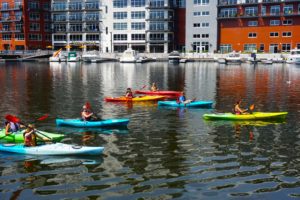 Such an integrated water approach will reduce property damage, protect human safety and public health, and create a foundation that supports strong economic development.
Such an integrated water approach will reduce property damage, protect human safety and public health, and create a foundation that supports strong economic development.
Here in Milwaukee, Wisconsin, many initiatives have been underway for years aimed at revitalizing the regional rivers, implementing green approaches in our urban core, and both protecting and restoring open space along the rivers and shores of Lake Michigan.
In Milwaukee, it’s all about water! We just need to connect the drops. To make this happen, a mix of projects from the present and the past are being employed.
In 1926, the Milwaukee Metropolitan Sewerage District (MMSD) began treating the City’s wastewater by not only providing cleaner water for the environment, but by also creating an organic nitrogen fertilizer, Milorganite®, to enhance soil health.
Using the biosolid byproduct of the wastewater treatment process to produce Milorganite® also provides needed revenue to offset the costs to the public. Over 90 years later, Milorganite® is still a sustainable approach that is revitalizing the Great Lakes, and helping to create food.
Building off this sustainable foundation, in the 1980’s, MMSD expanded the capacity of its water reclamation facilities by building a deep tunnel to help manage combined sewer overflows (CSO’s) and to eliminate sanitary sewer overflows.
Expanded twice since, this tunnel system has helped reduce CSO’s from an average of 50 per year to an average of just over two per year. Since 1994, MMSD has captured and cleaned 98.4% of all the water that has found its way into the regional sewer system. This has been contributing greatly to the restoration of Lake Michigan.
The amazing performance of the deep tunnel system has resulted in water quality improvements in the region’s rivers and has facilitated the natural revitalization of the rivers. No longer do the rivers stink, nor are they trash-laden. Condos, restaurants, and bars now line this river amenity.
In the 1990’s, the City of Milwaukee spurred this redevelopment effort along by better-connecting Milwaukee to its water via the construction of a River Walk. This system of walkways has created enhanced access to the waterways for people from all over the region to enjoy our rivers.
In the late 1990’s, MMSD realized that it needed to also provide flood management along the rivers to protect those who lived near the rivers and to further foster economic development.
Prior improvements had straightened and lined the rivers with concrete.
MMSD initiated a multiyear approach that reversed this approach and restored the rivers to a more natural appearance by reintroducing meanders and habitat as part of the flood management program.
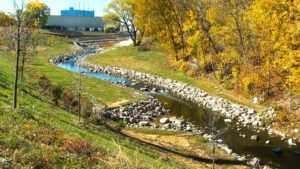
What that same stretch of river pictured above looks like today, naturalized, safer…and fish from Lake Michigan like it better too.
While not yet complete, the results are profound. Fish have returned and have begun to spawn, and the neighborhoods are embracing the quality of life improvements that the new open spaces have generated.
A cornerstone to MMSD’s flood management program is the preservation of open space through its Greenseams® Program. Greenseams® is a land acquisition program that identifies and preserves open spaces for flood mitigation, water quality improvements, and habitat restoration.
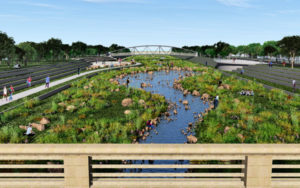
Artist’s rendering of what the Kinnickinnic River might look like in the future, after homes removed from floodplain and fully restored.
Once acquired by MMSD, this land is turned over to land trusts and municipalities with a conservation easement placed on it. These entities then manage the land and incorporate it into passive recreational programs.
Habitat is thus restored, and these natural open spaces act as sponges and help to absorb water before it floods downstream neighbors.
As these other efforts were completed or are ongoing, MMSD realized that, to get ahead of the water drops, it needed to manage water where it falls with green infrastructure. Today, green roofs, bioswales, rain barrels, porous pavement, and rain gardens are sprouting up throughout the Milwaukee region.
The green infrastructure program has taken the regionwide revitalization efforts and brought them down to the individual’s front yard.
This personalization of infrastructure puts water front and center on many discussions and helps to inform and teach the residents of the importance of good water stewardship. The transformation continues today every time a rain barrel or rain garden is installed.
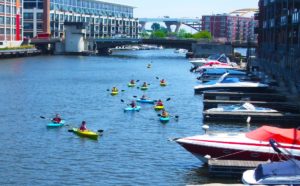 Unfortunately, there will be more Hurricane Harveys in the future. We cannot build traditional infrastructure large enough to withstand this type of storm. It is cost prohibitive and, in the end, futile, because there will always be a larger storm in the future.
Unfortunately, there will be more Hurricane Harveys in the future. We cannot build traditional infrastructure large enough to withstand this type of storm. It is cost prohibitive and, in the end, futile, because there will always be a larger storm in the future.
What we can do is make sure that our infrastructure – all infrastructure – is resilient and can respond quickly to minimize the impacts to our public. We need to change the way we develop our cities, like what MMSD is accomplishing in Milwaukee.
We cannot build our way out of events like Hurricane Harvey; however, if we get homes and businesses out of the floodplain, preserve open space in low areas, take steps to reduce impervious cover, manage some water where it falls, and try to work with nature, we can reduce the storms long term impacts. These newer approaches compliment a very robust grey infrastructure that includes flood management projects, the tunnel, sewers, and our water reclamation facilities.
In the end, proper management of water through land use planning and holistic approaches will help us revitalize our cities and reduce the impacts of future storms on our residents. It is all about restoring and reconnecting to water! We just need to connect the drops.
About the Author
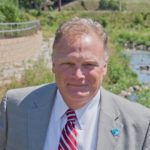 Kevin L. Shafer, P.E. has been Executive Director of the Milwaukee Metropolitan Sewerage District since 2002. As Executive Director, he is responsible for the overall management, administration, leadership, and direction of MMSD.
Kevin L. Shafer, P.E. has been Executive Director of the Milwaukee Metropolitan Sewerage District since 2002. As Executive Director, he is responsible for the overall management, administration, leadership, and direction of MMSD.
Under his leadership, MMSD instituted a regional stormwater runoff rule and has been a leader for innovative ways to manage stormwater runoff. His regional leadership was recognized through the District’s receipt of the 2012 U.S. Water Prize, awarded by the U.S. Water Alliance.
Prior to joining the District, Shafer spent 10 years in private industry and six years with the U.S. Army Corps of Engineers in Fort Worth, Texas. He is a past president of the National Association of Clean Water Agencies. Currently, Kevin is the Chair of the Water Environment Research Foundation and of the U.S. Water Alliance’s Urban Water Sustainability Leadership Council.
Shafer received a bachelor’s degree in science and civil engineering with a specialty in water resources from the University of Illinois and a master’s in civil engineering from the University of Texas. His professional recognition also includes:
- 2007 – Kodak’s American Greenways Award
- 2012 – University of Wisconsin’s LaFollette School of Public Affairs, Lloyd D. Gladfelter Award
- 2013 – Milwaukee River District’s Daniel H. Burnham Visionary Award
- 2014 – Public Policy Forum’s Norman N. Gill Award for Individual Excellence
- 2015 – NACWA’s Local Public Service Award
- 2015 – American Academy of Environmental Engineer’s Edward J. Cleary Award
All images courtesy of MMSD.


